Institute of Oceanology, Chinese Academy of Sciences
Article Information
- RU Xiaoshang, ZHANG Libin, LI Xiaoni, LIU Shilin, YANG Hongsheng
- Development strategies for the sea cucumber industry in China
- Journal of Oceanology and Limnology, 37(1): 300-312
- http://dx.doi.org/10.1007/s00343-019-7344-5
Article History
- Received Nov. 21, 2017
- accepted in principle Jan. 4, 2018
- accepted for publication Feb. 27, 2018
2 Laboratory for Marine Ecology and Environmental Science, Qingdao National Laboratory for Marine Science and Technology, Qingdao 266071, China;
3 University of Chinese Academy of Sciences, Beijing 100049, China
There are more than 140 species of sea cucumbers have been classified in China, and about 20 species are edible according to historical records (Liao, 1997). Of these, the Japanese sea cucumber Apostichopus japonicus is the most economically important and valuable species. Apostichopus japonicus belongs to the Family Stichopodidae, Order Aspidochirotida, Class Holothuroidea in the Phylum Echinodermata (Liao, 1997; Zhao, 2015). Apostichopus japonicus is widely distributed in the Yellow Sea and the Bohai Sea in China, inhabiting shallow areas with reef substrates, abundant food supply, slow water currents, and no fresh water input (Liu, 2015).
According to historical records, Chinese people began eating sea cucumber in the Ming Dynasty, and it was listed as one of the top "eight sea treasures". Based on its health benefits, sea cucumber was considered the "ginseng of the sea" (Xia and Wang, 2015; Yang and Bai, 2015). In addition, sea cucumber has been believed to possess medicinal functions. The Supplement to the Compendium of Materia Medica in the Qing Dynasty reads, "The sea cucumber with black thorns produced in Liaodong is the best, which benefits to promote spermatogenesis and hematopoiesis" (Xia and Wang, 2015; Yang and Bai, 2015). Recently, biochemical analysis has revealed that the sea cucumber body wall is rich in nutrients and bioactive substances, such as amino acids, fatty acids, mucopolysaccharides and microelements (Li et al., 2006; Liu et al., 2011b; Xia and Wang, 2015; Yang and Bai, 2015). Economic development has improved food quality so that the Chinese people now enjoy a higher standard of living. Therefore, the market requirement and consumption of sea cucumbers has gradually increased in the past decade. As a result, the sea cucumber farming industry in China has been developing rapidly in order to meet the increasing market demand. According to data from the China Fishery Statistical Yearbook, the yield, mariculture area, and quantity of sea cucumber seedlings have greatly increased in recent years (Fisheries and Fisheries Administration Bureau of the Ministry of Agriculture, 1998–2017). By 2016, the mariculture area, yield and quantity of seedling were 21.8×104 hm2, 20.44×107 kg and 63.1 billion, respectively (Fisheries and Fisheries Administration Bureau of the Ministry of Agriculture, 2017). These data indicate that sea cucumber has become a key aquaculture species in China bringing significant economic benefits nationally (Fig. 1).
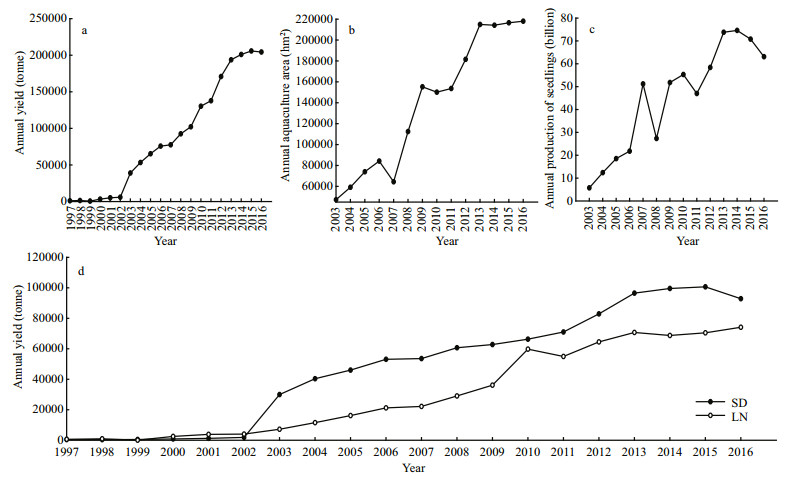
|
| Fig.1 Dynamic development of the sea cucumber aquaculture industry in China in the past twenty years a. annual yield; b. annual aquaculture area; c. annual production of seedlings; d. annual yield of sea cucumbers in the Shandong and Liaoning Provinces. SD: Shandong Province; LN: Liaoning Province. Data were collected from China Fishery Statistical Yearbook (Fisheries and Fisheries Administration Bureau of the Ministry of Agriculture, 1998–2017) |
The life cycle of A. japonicus includes a pelagic auricularia larval stage, a benthic doliolaria stage, followed by a pentactula stage, which transitions into an early juvenile with ambulacral podia, and a final metamorphosis into the juvenile stage and the mature stage (Qiu et al., 2015).
Biological characteristics of A. japonicus include autolysis, aestivation, evisceration, and regeneration (Yang et al., 2014). Since A. japonicus is a typical temperate species, aestivation is employed as a strategy to adapt to high temperatures in summer. During aestivation, A. japonicus will stop feeding, become inactive, degrade the entire intestine, lose body mass, and reduce basal metabolism (Wang et al., 2015b). Evisceration is a defense mechanism for A. japonicus when they encounter chemical or physical stress. The missing organs and appendages can concurrently regenerate when conditions become favorable (Wang et al., 2015b). Likewise, autolysis by endogenous proteolytic enzymes in the muscle tissue takes place when A. japonicus is under environmental stress (Zhu et al., 2008).
2.2 Aquaculture technology is developing rapidlySea cucumber aquaculture technology has been developing rapidly in China since the 1990s (Liu et al., 2015a). A series of effective aquaculture technologies based on sea cucumber biology have been constructed. These technologies include brood stock conditioning, larval rearing, juvenile rearing and brood stock rearing technologies, and several key technical indicators, including optimal water temperature, illumination intensity, salinity, stocking density and feed component have been determined in the last decade (Table 1). Several aquaculture models of adult A. japonicus also have been established (Fig. 2), such as bottom culture, pond culture, industrial culture, and cage culture methods (Zhang et al., 2015a).

|
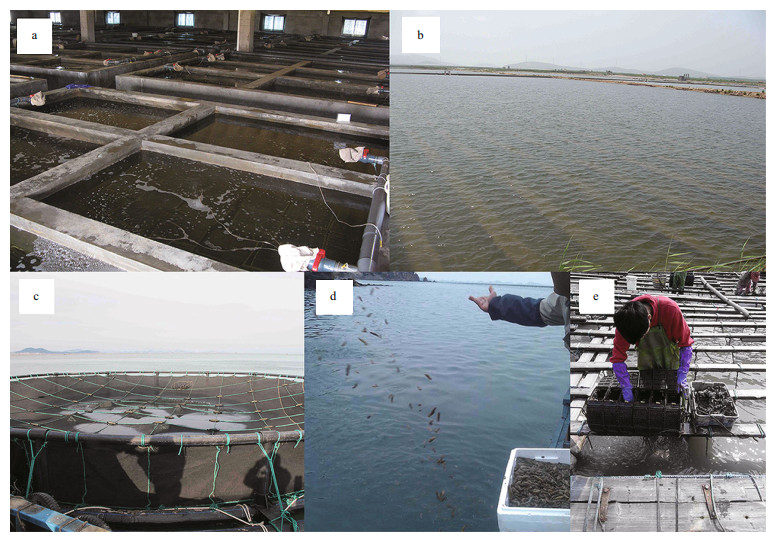
|
| Fig.2 Aquaculture models for sea cucumbers a. industrial culture model; b. pond culture model; c. large-scale cage culture model in the sea; d. bottom culture model in the sea; e. raft culture model in the sea. Photographs by LIU Shilin, XU Qinzeng, and QIU Tianlong. |
Aquaculture facilities play an important role in improving the yield of sea cucumbers. Recently, specialized facilities including multilayered-plates reef systems, oyster-shell reef systems, and multilayered-concrete reef systems have been explored (Zhang et al., 2011a, 2015a, b). These artificial reefs can provide the suitable ecological conditions and abundant diet for optimum rearing of sea cucumbers in order to promote aquaculture success (Fig. 3).
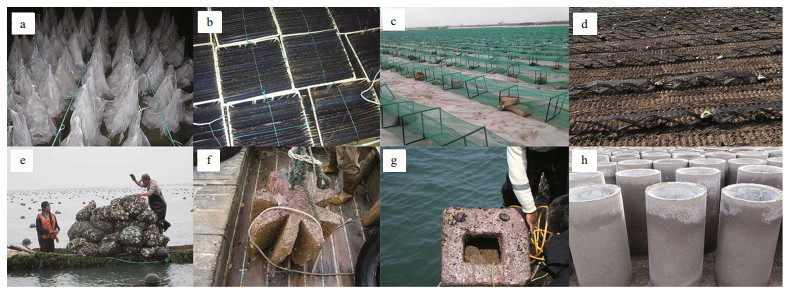
|
| Fig.3 Aquaculture facilities used in sea cucumber production a. netting system used in nursery tanks; b. multilayer system used in nursery tanks; c. cage system used in ponds; d. netting system used in ponds; e. oystershell reef system used in shallow seas; f. star type reef system used in shallow seas; g. square type reef system used in shallow seas; h. barrel type reef system used in shallow seas. Photographs by LIU Shilin, ZHANG Chuantao, XU Qinzeng, LI Jiao. |
Rearing sea cucumber varieties in culture has proven to be challenging due to the long period of first sexual maturity and the difficulty of genetic control of quantitative traits. To date, there are only two new varieties of A. japonicus (i.e. "Shuiyuan No. 1" and "Kongtong Island No. 1") in China (Liu et al., 2013; Yang et al., 2015). Both of these varieties show increased growth rates compared to natural populations (Table 4).
Over the past 30 years, sea cucumber aquaculture has become an important regional industry in the Liaodong Peninsula, the Shandong Peninsula and the Fujian Province. An indoor high-density hatchery of seedling cultivation and an outdoor polyculture of various economic species have been developed. An industrial chain of sea cucumber farming sites, primary processing and deep processing sites have been constructed in China.
2.3 Health care function research is gradually developingThe health value of sea cucumbers as a traditional preferred food has been documented from ancient times. The studies of the pharmacological actions of active components in A. japonicus have been gradually uncovered, and some components have been used as drugs for clinical treatment.
Research on pharmacologically relevant compounds in sea cucumber over past 20 years, have discovered medicinal functions of polysaccharides, polypeptide and the protein holothurin (Zhao et al., 2011; Xia and Wang, 2015). Previous studies have found that such active compounds can promote hematopoietic ability and promote blood circulation to remove blood stasis (Yang and Bai, 2015). In addition, these compounds may also play an important role in anti-tumor, anti-oxidation, enhanced immunity, anti-aging and anti-fatigue functions in the immune system (Yang and Bai, 2015). Therefore, the medicinal value of A. japonicus has been emerging as an important aspect of the development of marine drugs. Continued research on A. japonicus shows great possibilities for potential immune dysfunction treatments in the future.
3 PROBLEMS OF SEA CUCUMBER INDUSTRYAlthough the development of the sea cucumber industry was rapid in recent years, the industry is now encountering a bottleneck. Several issues are demanding prompt solutions, such as the lack of basic biology research and abnormal climates in summer. The subjective and objective problems faced by the sea cucumber industry, may affect the sustainability of the aquaculture industry, the consumption market, and the functional sustainability of sea cucumbers providing potential health products.
3.1 Biological concerns on biological studiesAt present, research on the basic biology of A. japonicus is relatively weak and far behind the development of the A. japonicus aquaculture industry. For example, research on biological phenomena such as aestivation, autolysis, evisceration, regeneration, and albinism are still at the initial stages. However, the physiologic characteristics of sea cucumbers such as aestivation, evisceration, and autolysis have a close relationship with yield in aquaculture. Therefore, it is necessary to associate the industrial demands with the scientific payoffs to achieve sustainable development of the industry.
The technology of molecular marker-assisted selection in A. japonicus is just beginning, thus the guidelines of practice in the field of sea cucumber breeding have not been established (Xu et al., 2014). In addition, due to the limited understanding of basic biological characteristics, sea cucumber culture is plagued by disease throughout the farming process.
Compared to other aquatic animals such as shrimp, the diagnosis of A. japonicus diseases is ambiguous, and the real-time detection methods are still not known (Chen et al., 2015). Moreover, researches on pathogenic mechanisms and epidemic trends of A. japonicus are still unclear (Chen et al., 2015; Han et al., 2016).
3.2 Germplasm degradation and lack of good varietiesDue to overfishing, habitat destruction, and other human factors, the safety of the sea cucumber germplasm resources is seriously being threatened. This may cause serious consequences. For example, the body size of a sexually mature individual is reducing, quantitative characteristic (i.e. numbers of thorn) is becoming single, the growth rate is becoming slow, and the resistant ability to changing environments is becoming poor. Germplasm degradation in sea cucumbers may become more serious in the future. On the one hand, due to the lack of habitat protection, wild resources will decline rapidly. On the other hand, due to increased use of bottom sowing culture pattern (Zhang et al., 2015a), unwanted genetic crosses may occur from hybridization with nearby native populations.
In addition, spring and autumn are the traditional fishing seasons for sea cucumbers. Spring is also the key season for gonadal development of sea cucumbers (Wang et al., 2015a). While generally, larger animals are easier to be found, this results in a large number of breeding individuals were caught.
Moreover, the brood stock used for artificial breeding is mainly collected from a cofferdam pond, in which the age of first sexual maturity is young (about two years) and the genetic diversity is low. Thus, the gamete quality is always difficult to control during artificial breeding (Liu et al., 2015b). Although the current scale of sea cucumber breeding is large, special varieties with high-quality economic characteristics are few compared with other aquaculture species, and the lack of improved varieties restricts the development of the sea cucumber farming industry.
3.3 Environment stress resulting from global climate changeAs a result of global climate change, the marine environment has shown a global trend of increasing water temperature and acidity with a corresponding decrease in dissolved oxygen. In recent years, sea cucumber aquaculture has responded negatively to these global changes, resulting in significant economic losses. For example, in the summers of 2013 and 2016, there was continuous hot weather in the coastal areas of northern China, resulting in large-scale death of sea cucumbers in the Shandong Peninsula.
Sea cucumbers are sensitive to the effects of environmental stress, including hyperthermia and acidification. Under these conditions, growth and metamorphosis rate are depressed, and the mortality rate increases in the larvae stage (Table 2). Growth is depressed in the juvenile stage (Table 2). For adults, high temperature can lead to aestivation, decreased metabolic activity, and depressed gonadal development (Table 2). In addition, acute heat stress causes rapid death in sea cucumbers, and the mortality rate is 77.2% in five days at 32℃ (Xu et al., 2014). Therefore, the scientific site selection of aquaculture ponds and the rational utilization of cooling and aerobic facilities are key strategies for the sea cucumber aquaculture industry to combat the effects of global climate change.
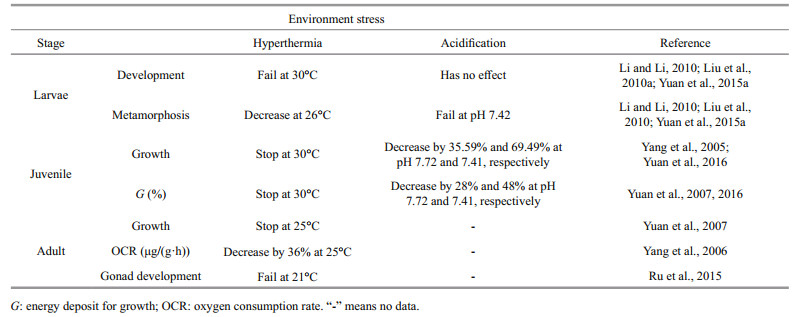
|
The current unit yield of A. japonicus in the traditional aquaculture model is approximately 937 kg/hm2 and the cultivation period of commercial A. japonicus is estimated at 2–3 years (Fisheries and Fisheries Administration Bureau of the Ministry of Agricultures, 1998–2017; Liu et al., 2015a). These poor numbers reflect the low efficiency of the traditional aquaculture models (Fig. 4).
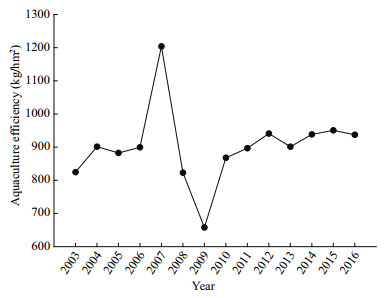
|
| Fig.4 Dynamic changes of sea cucumber aquaculture efficiency in China from 2003 to 2016 Data were collected from China Fishery Statistical Yearbook (Fisheries and Fisheries Administration Bureau of the Ministry of Agriculture, 2004–2017). |
The primary reason for this phenomenon is due to non-standard aquaculture techniques and extensive management. For example, due to the low quality of diet and inappropriate substrate materials, the deterioration of water quality in ponds could lead to a large-scale mortality rate of A. japonicus resulting in reduced production. In addition, A. japonicus as a benthic deposit feeder has the biological characteristics of low digestive ability and growth rate (Table 3). However, in most aquaculture regions, A. japonicus animals are cultivate separately. Therefore the upper and middle waters cannot be used fully. This contributes another critical reason for low aquaculture efficiency.

|
The use of A. japonicus for marine drugs relies on nutrition facts of component polysaccharides, polypeptides and saponins in the body wall or gonadal tissues. While knowledge about the function of active substances such as cerebrosides is lacking, these components have been shown in other sea cucumber species to play an important role in the prevention of fatty liver (Xu et al., 2011).
Currently, in order to adapt to consumer demand, the processing capacity of sea cucumbers has been constantly improved (Mao et al., 2015). Processed products including instant food and capsules are in mass production in addition to traditional products (Fig. 5). However, due to the limitation of research method, and the complexity of sea cucumber active ingredients, there remain very few studies addressing the physiological and pharmacological regulation mechanisms of these compounds. Therefore, a comprehensive study of the health care functions in A. japonicus is relatively lagging behind the market demand. This may hinder A. japonicus sustainable development in the pharmaceutical, health and food industries.
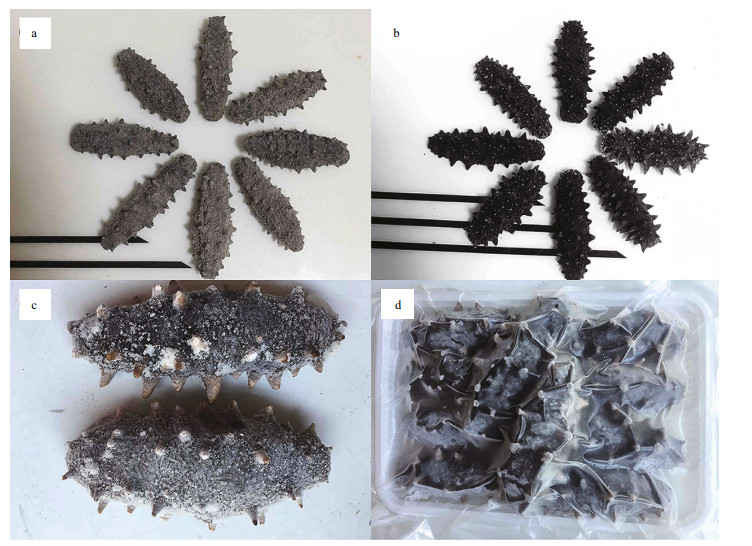
|
| Fig.5 Traditional processing methods of sea cucumbers a. salted-drying; b. unsalted-drying; c. freeze-drying; d. high pressure and vacuum-cooking. Photographs by JIANG Lingxu. |
Apostichopus japonicus is a rare seafood with high nutrition value that has gained great attention among consumers in the market. However, domestic food safety problems have been frequent in recent years. The phenomena of antibiotic residues and processing fraud have repeatedly occurred, seriously affecting the sustainable development of the A. japonicus market.
Food safety problems in A. japonicus occur in aquaculture and processing. Regarding aquaculture, the blanket use of antibiotics and additives damage the ecological balance of aquaculture water, and impair the physiological function of A. japonicus (Lv and Zhou, 2005; Liu et al., 2011a; The Xinhua News Agency, 2014; Han et al., 2016; Yang et al., 2017). In processing, several processing companies prepare dry A. japonicus with sodium hydroxide and syrup in order to reduce soaking time and increase the wet weight after soaking (Liu et al., 2010b; Wang et al., 2013; Luo et al., 2014). The addition of harmful preservatives, such as formaldehyde could cause serious food safety problems as well (Zhang et al., 2012; Li, 2013). Taken together, these factors will damage sustainable development of A. japonicus in coastal fish markets.
4 DEVELOPMENT STRATEGY FOR THE SEA CUCUMBER INDUSTRY 4.1 Improving knowledge of biological characteristics based on the sea cucumber genomeIn view of the weakness of basic biology research, the basic theory and application technology of A. japonicus biology should be strengthened. As a foundational basis of sea cucumber biology, the complete sequence of the sea cucumber genome should be efficiently used (Jo et al., 2017; Zhang et al., 2017). First, genomic data can provide information on the molecular mechanism of dormancy, body color control, and regeneration to better understanding lifehistory strategies in A. japonicus. In addition, genomic data can also be used for promoting high-quality traits including body thorns, heat-resistance, diseaseresistance, and fast growth in A. japonicus.
Moreover, in order to better control diseases during aquaculture, disease-related immune genes in the A. japonicus genome are necessary. These genes could help explore pathogenesis, produce new drugs, and develop antiviral vaccines in view of molecular mechanism. Disease research should be closely associated with aquaculture practices, so that largescale infectious disease can be controlled in culture further guaranteeing sustainable development of A. japonicus in the aquaculture industry.
4.2 Improving aquaculture technology based on behavioral studiesChallenges in sea cucumber aquaculture include selection of appropriate farming sites, uncontrollable distribution of farming animals, low recapture rate of farming animals, and low efficiency of fishing style (Fig. 6). Research concerned with the behavioral ecology of sea cucumbers can effectively address the problems mentioned above.

|
| Fig.6 Traditional fishing methods of sea cucumbers: dive-fishing a. divers searching for sea cucumbers; b. harvesting sea cucumbers in mesh bags; c. harvesting sea cucumbers. Photographs by JIANG Lingxu. |
Behaviors of sea cucumbers include movement, feeding, and habitat selection (Pan et al., 2015; Sun et al., 2015; Ru et al., 2017). Researchers are paying attention to the behavior of sea cucumbers due to the significant scientific value of this information poses for aquaculture. For example, understanding feeding behavior and digestive physiology, the feeding rhythms (peaks at 02:00–04:00) of sea cucumbers can be determined (Sun et al., 2015). This information can provide guidance for more efficient feeding strategies for factory farming. Moreover, behavioral data also can provide theoretical support for the development of aquaculture and trapping facilities (Zhang et al., 2011a).
4.3 Improving aquaculture varieties based on modern breeding technologyDirectional selection of wild populations and improvement of high-quality economic traits, using modern biological technology and genetic principles, provide crucial support for the sea cucumber aquaculture industry. For example, the filial generation, which was a hybridization between Russian population and Chinese population of sea cucumbers, showed an obvious increase in growth rate and survival rate (Table 4). Other traits, including white color, purple color, and six rows of papilla are constructed now (Chang et al., 2011; Bai et al., 2015). These high-quality strains will lay the foundation for the diversification of aquaculture species (Fig. 7).
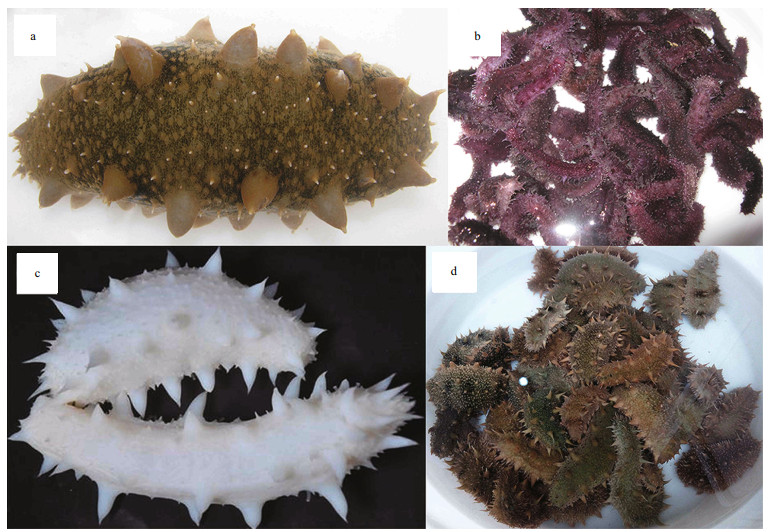
|
| Fig.7 Seed selecting of sea cucumbers a. Kongtong Island No. 1; b. purple color strain; c. white color strain; d. fast-growth and heat-resistance strain. Photographs by YANG Jianmin and LIU Shilin. |
Development of co-culture patterns is beneficial for the efficient use of limited aquaculture space, the increase of diet utilization and decrease of output of aquaculture waste, as well as increasing economic benefits. Apostichopus japonicus, as a typical benthic deposit feeder, can effectively reduce the organic content in aquaculture systems (Yuan et al., 2015b; Zamora et al., 2018). For example, the development of tridimensional aquaculture patterns, such the polyculture of sea cucumber with shellfish, abalone, jellyfish, sea urchin and fish can significantly improve the utilization efficiency of water resources (Yuan et al., 2015b). In addition, sea cucumbers can transform biological sediments in polyculture systems into body tissues at rates of 0.8–4.6 and 0.3–0.8 mg/(g·d) for carbon and nitrogen, respectively (Yuan et al., 2015b). Another example, the interactive polyculture of sea cucumber and shrimp can harvest extra shrimp (150 kg/ hm2) in A. japonicus aestivation (He et al., 2008).
The use of modern aquaculture facilities can significantly improve the aquaculture density, and thus significantly improve the unit yield and aquaculture efficiency (Lin and Zhang, 2015). Based on the biological characteristics of A. japonicus, and the shallow water environment in China, environmentally friendly facilities such as oystershell reefs can not only increase sea cucumber aquaculture efficiency to 20 ind./m2, but also provide habitats for other invertebrates. Such a system will have positive effects on marine resources and habitat rehabilitation (Zhang et al., 2015b).
4.5 Establishing a traceable system of food safety and qualityThe ultimate quality of sea cucumber products can be affected by seedling production, aquaculture, processing and preservation (Zhang et al., 2014a). Therefore, it is necessary to establish a sophisticated traceable system in order to guarantee food safety of sea cucumbers over the entire production scheme. Every level of production should participate in the construction of the quality control system, from sea cucumber aquaculture, to processing and marketing.
Moreover, it is necessary to establish the national standard of sea cucumber product safety, standardize the production of dried sea cucumbers and the order of market competition. Efforts such as these will promote a healthy and sustainable sea cucumber market.
In order to address consumer concerns about the abuse of antibiotics, drug residue detection should be strengthened. In addition, research on highly efficient and green antibiotics should be the focus of current work. The use of Chinese herbal preparations and microbial preparations to prevent and treat diseases should be widely promoted. For example, the addition of 3% (w/w) astragalus polysaccharide in the diet can improve immunity, enhance resistance to pathogens and promote growth by 30.03% of A. japonicus (Sun et al., 2009; Wang et al., 2009).
4.6 Exploring health care functions based on modern medical technologyWith the improved living standard of Chinese people, consumers pay more attention to the health care functions of A. japonicus. Therefore, future studies should combine modern marine biotechnology and modern medical technology to evaluate the health care functions of sea cucumbers more comprehensively and scientifically (Xia and Wang, 2015). Exploring the pharmacological mechanisms of active ingredients from A. japonicus should be another important area of focus.
Regarding extraction of active substances from A. japonicus, future studies should combine the advanced technology of modern physical and chemical purification methods, and establish the industrial standard of the purification process to ensure the quality and purification efficiency of active substances. In addition, research on the genome of A. japonicus can provide the scientific basis for the development of new functional food and health products. For example, future studies can use known gene sequences to manufacture synthetic substitutes of active compounds. In this way, the health care products from A. japonicus can be produced on a large scale to advance a broad application of prospects.
5 DATA AVAILABILITY STATEMENTThe data that support the findings of this study are available in the China Fishery Statistical Yearbook (Fisheries and Fisheries Administration Bureau of the Ministry of Agriculture, 1998–2017).
6 ACKNOWLEDGEMENTWe are grateful to XU Qinzeng, JIANG Lingxu, ZHANG Chuantao, LI Jiao, QIU Tianlong and YANG Jianmin for providing the photographs. And we are also grateful to WU Yi for her excellent work in image editing.
An Z H, Dong Y W, Dong S L. 2007. Temperature effects on growth-ration relationships of juvenile sea cucumber Apostichopus japonicus (Selenka). Aquaculture, 272(1-4): 644-648.
DOI:10.1016/j.aquaculture.2007.08.038 |
Bai Y C, Zhang L B, Liu S L, Ru X S, Xing L L, Cao X B, Zhang T, Yang H S. 2015. The effect of salinity on the growth, energy budget and physiological performance of green, white and purple color morphs of sea cucumber, Apostichopus japonicus. Aquaculture, 437: 297-303.
DOI:10.1016/j.aquaculture.2014.12.020 |
Chang Y Q, Shi S B, Zhao C, Han Z H. 2011. Characteristics of papillae in wild, cultivated and hybrid sea cucumbers(Apostichopus japonicus). African Journal of Biotechnology, 10(63): 13 780-13 788.
DOI:10.5897/AJB |
Chen M Y, Wang F Y, Xing K, Zhu A J, Zhang S S. 2015.Immunology and diseases. In: Yang H S, Hamel J F, Mercier A eds. The Sea Cucumber Apostichopus Japonicus: History, Biology and Aquaculture. Academic Press, Amsterdam, The Netherlands. p.257-287.
|
Fisheries and Fisheries Administration Bureau of the Ministry of Agriculture. 1998-2017. China Fisheries Yearbook.China Agriculture Press, Beijing, China. (in Chinese)
|
Han Q X, Keesing J K, Liu D Y. 2016. A review of sea cucumber aquaculture, ranching, and stock enhancement in China. Reviews in Fisheries Science & Aquaculture, 24(4): 326-341.
|
He Z P, Wang X Y, Liu Y F, Liu Y H, Wang X. 2008. A high efficiency polyculture of sea cucumber Apostichopus japonicus with kuruma prawn Penaeus japonicus in pond. Fisheries Science, 27(12): 665-667.
(in Chinese with English abstract) |
Hu M Y, Li Q, Kong L F, Li L. 2009. Comparative study on juvenile growth of hybrids between Chinese and Japanese stocks of sea cucumber (Stichopus japonicus). Periodical of Ocean University of China, 39(S1): 375-380.
(in Chinese with English abstract) |
Jo J, Oh J, Lee H G, Hong H H, Lee S G, Cheon S, Kern E M A, Jin S, Cho S J, Park J K, Park C. 2017. Draft genome of the sea cucumber Apostichopus japonicus and genetic polymorphism among color variants. Giga Science, 6(1): 1-6.
|
Key Laboratory of Marine Ecology and Environmental Sciences of IOCAS. 2016. Information about fast-growth and heat-resistance strain of sea cucumber Apostichopus japonicus. http://www.qdio.cas.cn/xwzx/kydt/201611/t20161116_4696970.html. Accessed on 2016-11-16. (in Chinese)
|
Li D T, Chang Y Q, Chen W, He Y M, Li Y, Zhong L, Zhang Y Y, Pan W. 2006. Analysis of nutritive composition of body wall in wild Apstichopus japonicus Selenka at Zhangzi Island. Journal of Dalian Fisheries University, 21(3): 278-282.
(in Chinese with English abstract) |
Li L, Li Q. 2010. Effects of stocking density, temperature, and salinity on larval survival and growth of the red race of the sea cucumber Apostichopus japonicus (Selenka). Aquaculture International, 18(3): 447-460.
DOI:10.1007/s10499-009-9256-4 |
Li X Q. 2013. Research on Crucial Indexes in Quality Evaluation of Several Stichopus Japonicus Products. Ocean University of China, Qingdao, China. p.7-8.
(in Chinese)
|
Liang M, Dong S L, Gao Q F, Wang F, Tian X L. 2010. Individual variation in growth in sea cucumber Apostichopus japonicus (Selenck) housed individually. Journal of Ocean University of China, 9(3): 291-296.
DOI:10.1007/s11802-010-1739-4 |
Liao Y L. 1997. Fauna Sinica. Beijing, China. 334p.
(in Chinese)
|
Lin C G, Zhang L B. 2015. Habitat enhancement and rehabilitation. In: Yang H S, Hamel J F, Mercier A eds.The Sea Cucumber Apostichopus Japonicus: History, Biology and Aquaculture. Academic Press, Amsterdam, The Netherlands. p.333-351.
|
Liu G B, Sun J C, Liu S L. 2015a. From fisheries toward aquaculture. In: Yang H S, Hamel J F, Mercier A eds. The Sea Cucumber Apostichopus Japonicus: History, Biology and Aquaculture. Academic Press, Amsterdam, The Netherlands. p.25-35.
|
Liu G B, Yang H S, Liu S L. 2010a. Effects of rearing temperature and density on growth, survival and development of sea cucumber larvae, Apostichopus japonicus (Selenka). Journal of Oceanology and Limnology, 28(4): 842-848.
DOI:10.1007/s00343-010-9092-4 |
Liu J X. 2015. Spatial distribution, population structures, management, and conservation. In: Yang H S, Hamel J F, Mercier A eds. The Sea Cucumber Apostichopus japonicus: History, Biology and Aquaculture. Academic Press, Amsterdam, The Netherlands. p.77-86.
|
Liu Q, Cao R, Wang L Z, Yin B Z. 2010b. Effect of soaking parameters on dried sea cucumber processing. Innovational Edition of Farm Products Processing, (11): 46-48, 70.
(in Chinese with English abstract) |
Liu S L, Sun J C, Ru X S, Hamel J F, Mercier A. 2015b.Broodstock conditioning and spawning. In: Yang H S, Hamel J F, Mercier A eds. The Sea Cucumber Apostichopus Japonicus: History, Biology and Aquaculture. Academic Press, Amsterdam, The Netherlands. p.101-108.
|
Liu T G, Zhao W, Guo K. 2011a. The research survey on toxicity and toxicology of toxicant in Apostichopus japonicus culture. Beijing Agriculture, (21): 11-13.
(in Chinese with English abstract) |
Liu W, Chang Y Q, Ding J. 2013. A preliminary study of effects of mild and acute drop of temperature on serum nonspecific immunity in "Shuiyuan No.1" sea cucumber populations and the cultured sea cucumber populations. Journal of Fisheries of China, 37(9): 1 342-1 348.
(in Chinese with English abstract) DOI:10.3724/SP.J.1231.2013.38659 |
Liu X F, Xue C H, Wang Y M, Li H Y. 2011b. Comparative analysis of nutritive composition in body wall and internal organs of sea cucumber (Apostichopus japonicus) at Rushan. Journal of Fisheries of China, 35(4): 587-593.
(in Chinese with English abstract) |
Liu Y, Dong S L, Tian X L, Wang F, Gao Q F. 2009. Effects of dietary sea mud and yellow soil on growth and energy budget of the sea cucumber Apostichopus japonicus(Selenka). Aquaculture, 286(3-4): 266-270.
DOI:10.1016/j.aquaculture.2008.09.029 |
Luo Y H, Chen J, Wang G M. 2014. Determination of illegal adding of industrial sodium hydroxide in sleeve-fish, sea cucumber and raw milk. Journal of Food Safety & Quality, 5(10): 3 255-3 259.
(in Chinese with English abstract) |
Lv H, Zhou B W. 2005. Acute toxicity of four drugs to juvenile sea cucumber (Apostichpus japonicus). Fisheries Science, 24(6): 28-31.
(in Chinese with English abstract) |
Mao Y Z, Huang Y, Liu Q. 2015. Processing and cuisine. In: Yang H S, Hamel J F, Mercier A eds. The Sea Cucumber Apostichopus Japonicus: History, Biology and Aquaculture. Academic Press, Amsterdam, The Netherlands. p.367-382.
|
Pan Y, Zhang L B, Lin C G, Sun J M, Kan R T, Yang H S. 2015. Influence of flow velocity on motor behavior of sea cucumber Apostichopus japonicus. Physiology & Behavior, 144: 52-59.
|
Pei S R, Dong S L, Wang F, Tian X L, Gao Q F. 2012. Effects of density on variation in individual growth and differentiation in endocrine response of Japanese sea cucumber (Apostichopus japonicus Selenka). Aquaculture, 356-357: 398-403.
DOI:10.1016/j.aquaculture.2012.04.032 |
Qiu T L, Zhang L B, Zhang T, Bai Y C, Yang H S. 2014. Effect of culture methods on individual variation in the growth of sea cucumber Apostichopus japonicus within a cohort and family. Journal of Oceanology and Limnology, 32(4): 737-742.
DOI:10.1007/s00343-014-3131-5 |
Qiu T L, Zhang T, Hamel J F, Mercier A. 2015. Development, settlement, and post-settlement growth. In: Yang H S, Hamel J F, Mercier A eds. The Sea cucumber Apostichopus Japonicus: History, Biology and Aquaculture. Academic Press, Amsterdam, The Netherlands. p.111-131.
|
Ru X S, Gao T X, Liu S L, Song S L, Yang H S. 2015. Effects of temperature on digestive and metabolic enzymes activities of sea cucumber (Apostichopus japonicus)brood-stock. Marine Sciences, 39(3): 1-6.
(in Chinese with English abstract) |
Ru X S, Zhang L B, Liu S L, Sun J C, Yang H S. 2018. Energy budget adjustment of sea cucumber Apostichopus japonicus during breeding period. Aquaculture Research, 49(4): 1 657-1 663.
|
Ru X S, Zhang L B, Liu S L, Yang H S. 2017. Reproduction affects locomotor behaviour and muscle physiology in the sea cucumber, Apostichopus japonicus. Animal Behaviour, 133: 223-228.
DOI:10.1016/j.anbehav.2017.09.024 |
Rural Economic Committee of Jinzhou. 2014. Information about "Shuiyuan No.1" in Jinzhou. http://jiuban.moa.gov.cn/fwllm/qgxxlb/ln/201406/t20140605_3926958.htm.Accessed on 2014-06-05. (in Chinese)
|
Sui X L, Chen Y, Hu Q M, Shang B L. 1985. Study of broodstock conditioning of the sea cucumber, Apostichopus japonicus. Fisheries Science, (3): 28-31.
(in Chinese) |
Sun J M, Zhang L B, Pan Y, Lin C G, Wang F, Kan R T, Yang H S. 2015. Feeding behavior and digestive physiology in sea cucumber Apostichopus japonicus. Physiology & Behavior, 139: 336-343.
|
Sun L Y, Zhao Q, Ren L H, Wang Y T, Wang L, He J B. 2013. Crossing and offspring development of sea cucumber Stichopus japonicus between Chinese and Korean populations. Journal of Dalian Ocean University, 28(3): 281-286.
(in Chinese with English abstract) |
Sun Y X, Li Y J, Wen Z X, Li X J, Shi L X, Xu Y P, Wang T T. 2009. Effects of dietary supplemented with Astragalus membranaceus and Astragalus polysaccharides on growth performance in sea cucumber. China Feed, (4): 31-46.
(in Chinese with English abstract) |
The Xinhua News Agency. 2014. Antibiotics abusee in culturing of sea cucumber Apostichopus japonicus in Bohai gulf. Contemporary Animal Husbandry, 27(9): 72.
(in Chinese) |
Wang L Z, Li X Q, Gu X H, Li Y, Zhu W J, Song C L, Yin B Z. 2013. A method for determination of exogenous total sugar in dried sea cucumber. Food Science, 34(14): 293-297.
(in Chinese with English abstract) |
Wang Q, Zhang T, Hamel J F, Mercier A. 2015a. Reproductive biology. In: Yang H S, Hamel J F, Mercier A eds. The Sea Cucumber Apostichopus Japonicus: History, Biology and Aquaculture. Academic Press, Amsterdam, The Netherlands. p.87-100.
|
Wang T M, Sun L N, Chen M Y. 2015b. Aestivation and regeneration. In: Yang H S, Hamel J F, Mercier A eds. The Sea Cucumber Apostichopus Japonicus: History, Biology and Aquaculture. Academic Press, Amsterdam, The Netherlands. p.177-209.
|
Wang T T, Sun Y X, Jin L J, Xu Y P, Wang L, Ren T J, Wang K L. 2009. Enhancement of non-specific immune response in sea cucumber (Apostichopus japonicus) by Astragalus membranaceus and its polysaccharides. Fish & Shellfish Immunology, 27(6): 757-762.
|
Xia S D, Wang X Y. 2015. Nutritional and medicinal value. In: Yang H S, Hamel J F, Mercier A eds. The Sea Cucumber Apostichopus Japonicus: History, Biology and Aquaculture. Academic Press, Amsterdam, The Netherlands. p.353-365.
|
Xia S D, Yang H S, Li Y, Liu S L, Zhou Y, Zhang L B. 2012. Effects of different seaweed diets on growth, digestibility, and ammonia-nitrogen production of the sea cucumber Apostichopus japonicus (Selenka). Aquaculture, 338-341: 304-308.
DOI:10.1016/j.aquaculture.2012.01.010 |
Xu D X, Sun L N, Liu S L, Zhang L B, Yang H S. 2014. Polymorphisms of heat shock protein 90 (Hsp90) in the sea cucumber Apostichopus japonicus and their association with heat-resistance. Fish & Shellfish Immunology, 41(2): 428-436.
|
Xu J, Wang Y M, Feng T Y, Zhang B, Sugawara T, Xue C H. 2011. Isolation and anti-fatty liver activity of a novel cerebroside from the sea cucumber Acaudina molpadioides. Bioscience, Biotechnology, and Biochemistry, 75(8): 1 466-1 471.
DOI:10.1271/bbb.110126 |
Yang G, Peng M, Tian X L, Dong S L. 2017. Molecular ecological network analysis reveals the effects of probiotics and florfenicol on intestinal microbiota homeostasis:an example of sea cucumber. Scientific Reports, 7(1): 4 778.
DOI:10.1038/s41598-017-05312-1 |
Yang H S, Bai Y C. 2015. Apostichopus Japonicus in the life of chinese people. In: Yang H S, Hamel J F, Mercier A eds.The Sea Cucumber Apostichopus Japonicus: History, Biology and Aquaculture. Academic Press, Amsterdam, The Netherlands. p.1-23.
|
Yang H S, Yuan X T, Zhou Y, Mao Y Z, Zhang T, Liu Y. 2005. Effects of body size and water temperature on food consumption and growth in the sea cucumber Apostichopus japonicus (Selenka) with special reference to aestivation. Aquaculture Research, 36(11): 1 085-1 092.
DOI:10.1111/are.2005.36.issue-11 |
Yang H S, Zhou Y, Zhang T, Yuan X T, Li X X, Liu Y, Zhang F S. 2006. Metabolic characteristics of sea cucumber Apostichopus japonicus (Selenka) during aestivation. Journal of Experimental Marine Biology and Ecology, 330(2): 505-510.
DOI:10.1016/j.jembe.2005.09.010 |
Yang H S, Zhou Y, Zhang T. 2014. Biology of the Sea Cucumber Apostichopus japonicus:Theory and Practice. Science Press, Beijing, China. p.1-11.
(in Chinese)
|
Yang J M, Song Z L, Wang W J, Sun G H, Wang Z P, Sun Y J. 2015. Introduction of a new variety of sea cucumber "Kongtong Island No.1". China Fisheries, (12): 55-57.
(in Chinese) |
Yuan X T, Shao S L, Dupont S, Meng L M, Liu Y J, Wang L J. 2015a. Impact of CO2-driven acidification on the development of the sea cucumber Apostichopus japonicus(Selenka) (Echinodermata:Holothuroidea). Marine Pollution Bulletin, 95(1): 195-199.
DOI:10.1016/j.marpolbul.2015.04.021 |
Yuan X T, Shao S L, Yang X L, Yang D Z, Xu Q Z, Zong H M, Liu S L. 2016. Bioenergetic trade-offs in the sea cucumber Apostichopus japonicus (Echinodermata:Holothuroidea)in response to CO2-driven ocean acidification. Environmental Science and Pollution Research, 23(9): 8 453-8 461.
DOI:10.1007/s11356-016-6071-0 |
Yuan X T, Yang H S, Wang L L, Zhou Y, Zhang T, Liu Y. 2007. Effects of aestivation on the energy budget of sea cucumber Apostichopus japonicus (Selenka)(Echinodermata:Holothuroidea). Acta Ecologica Sinica, 27(8): 3 155-3 161.
DOI:10.1016/S1872-2032(07)60070-5 |
Yuan X T, Zhou Y, Mao Y Z. 2015b. Apostichopus Japonicus: a key species in integrated polyculture systems. In: Yang H S, Hamel J F, Mercier A eds. The Sea Cucumber Apostichopus Japonicus: History, Biology and Aquaculture. Academic Press, Amsterdam, The Netherlands. p.323-332.
|
Zamora L N, Yuan X T, Carton A G, Slater M J. 2018. Role of deposit-feeding sea cucumbers in integrated multitrophic aquaculture:progress, problems, potential and future challenges. Reviews in Aquaculture, 10(1): 57-74.
|
Zhang L B, Song X Y, Hamel J F, Mercier A. 2015a.Aquaculture, stock enhancement, and restocking. In: Yang H S, Hamel J F, Mercier A eds. The Sea Cucumber Apostichopus Japonicus: History, Biology and Aquaculture. Academic Press, Amsterdam, The Netherlands. p.289-322.
|
Zhang L B, Yang H S, Xu Q, Xing K, Zhao P, Lin C G. 2011a. A new system for the culture and stock enhancement of sea cucumber, Apostichopus japonicus (Selenka), in cofferdams. Aquaculture Research, 42(10): 1431-1439.
DOI:10.1111/are.2011.42.issue-10 |
Zhang L B, Zhang T, Xu Q Z, Qiu T L, Yang H S, Liu S L. 2015b. An artificial oyster-shell reef for the culture and stock enhancement of sea cucumber, Apostichopus japonicus, in shallow seawater. Aquaculture Research, 46(9): 2260-2269.
DOI:10.1111/are.2015.46.issue-9 |
Zhang L L, Cao X B, Li J H, Liu J L, Hou M H, Zhou W J, Chang Y Q. 2013. Growth comparison of juvenile F1 Hybrids between Russia population and China population of sea cucumber Apostichopus japonicus. Fisheries Science, 32(2): 68-72.
(in Chinese with English abstract) |
Zhang P P, Li Q, Kong L F, Yu R H. 2011b. Effects of marine yeast (Rhodomonas sp.) and four different microalgal diets on larval growth and survival at metamorphosis in the sea cucumber Apostichopus japonicus. Periodical of Ocean University of China, 41(10): 30-34.
(in Chinese with English abstract) |
Zhang P, Dong S L. 2013. Effect of light intensity on the growth and energy allocation of green and red variants of Apostichopus japonicas Selenka. Journal of Fishery Sciences of China, 20(4): 778-784.
(in Chinese with English abstract) DOI:10.3724/SP.J.1118.2013.00778 |
Zhang R, Chen H, Zhao J H, Guo J, Chen Z T. 2012. Evaluation of uncertainty in measurement of formaldehyde content in waterishlogged food products by spectrophotometer. Taiwan Agricultural Research, (5): 73-77.
(in Chinese with English abstract) |
Zhang S C, Liu S L, Zhang L B, Ru X S, Yang H S. 2016. Effect of stocking density on key growth traits of a fastgrowing and heat-resistant strain of sea cucumber(Apostichopus japonicus). Aquaculture Research, 47(11): 3 636-3 643.
DOI:10.1111/are.2016.47.issue-11 |
Zhang W D, Yang Z Y, Yin X L, Pan L L. 2014a. Traceability system design for the quality and safety of sea cucumber products. Hubei Agricultural Sciences, 53(1): 200-203.
(in Chinese with English abstract) |
Zhang X J, Sun L N, Yuan J B, Sun Y M, Gao Q, Zhang L B, Li S H, Dai H, Hamel J F, Liu C Z, Yu Y, Liu S L, Lin W C, Guo K M, Jin S J, Xu P, Storey K B, Huan P, Zhang T, Zhou Y, Zhang J Q, Lin C G, Li X N, Xing L L, Huo D, Sun M Z, Wang L, Mercier A, Li F H, Yang H S, Xiang J H. 2017. The sea cucumber genome provides insights into morphological evolution and visceral regeneration. PLoS Biology, 15(10): e2003790.
DOI:10.1371/journal.pbio.2003790 |
Zhang Y S, Dong S L, Wang F, Tian X L, Gao Q F. 2014b. The effects of light intensity and photoperiod on the growth, survival, development and metamorphosis of sea cucumber (Apostichopus japonicus) larvae. Transactions of Oceanology and Limnology, (1): 36-41.
(in Chinese with English abstract) |
Zhao H. 2015. Taxonomy and identification. In: Yang H S, Hamel J F, Mercier A eds. The Sea Cucumber Apostichopus Japonicus: History, Biology and Aquaculture. Academic Press, Amsterdam, The Netherlands. p.37-52.
|
Zhao Q, Liu Z D, Xue Y, Wang J F, Li H, Tang Q J, Wang Y M, Dong P, Xue C H. 2011. Ds-echinoside A, a new triterpene glycoside derived from sea cucumber, exhibits antimetastatic activity via the inhibition of NF-κB-dependent MMP-9 and VEGF expressions. Journal of Zhejiang University Science B, 12(7): 534-544.
DOI:10.1631/jzus.B1000217 |
Zhu B W, Zhao L L, Sun L M, Li D M, Murata Y, Yu L, Zhang L. 2008. Purification and characterization of a cathepsin L-like enzyme from the body wall of the sea cucumber Stichopus japonicus. Bioscience, Biotechnology, and Biochemistry, 72(6): 1 430-1 437.
DOI:10.1271/bbb.70741 |
 2019, Vol. 37
2019, Vol. 37



